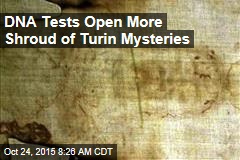
Furthermore it raises the possibility of an Indian manufacture of the linen cloth. Bilirubin was found in his blood to confirm this. Up until this point, scientists were able to discover that this man was not only beaten and tortured, but was crucified as well. When it was first photographed in 1898, a positive image of a man had shown in the negative prints. Previous analyses of the shroud have traced its origin to between 12 AD, though the chemistry of the linen fibers and the production method used doesnt. Another piece of evidence we can refer to is the Shroud of Turin.

Such mitogenome diversity could be due to contacts with subjects of different ethnic origins in recent centuries, but it is also compatible with the historic path followed by the Turin Shroud during its supposed 2000-year journey from the Near East. A team of Italian researchers has analyzed DNA obtained from the Shroud of Turin, a burial cloth thats traditionally thought to have covered Jesus. As for human mtDNAs, our analyses allowed the detection of sequences from multiple subjects, which clustered into a number of western Eurasian haplogroups, including some known to be typical of western Europe (H1 and H3), the Near East (H13 and H33), the Arabian Peninsula (R0a) and the Indian sub-continent (M56 and R8).

Since many of these species were introduced into Europe after the Marco Polo travels and Christopher Columbus voyages, our findings suggest a geographic scenario for which only some of the detected plant cpDNAs are compatible with the supposed origin and trail of the relic, whereas others are likely from a historical interval later than the Medieval period. Plant species native to the Mediterranean countries and widespread in the Middle East (Vavilov’s centers of origin V and IV, respectively) were identified, in addition to others living in temperate and boreal regions of the northern hemisphere or having their primary center of origin and distribution in central and eastern Asia (mainly China, I) or native only to the Americas. Specific plant chloroplast DNA (cpDNA) and human mitochondrial DNA (mtDNA) target regions were analyzed to identify plant taxonomic entities and human genetic lineages. Here we report the main findings from the analysis of genomic DNA extracted from dust particles, which were vacuumed from the backside of Turin Shroud corresponding to internal parts of the body image and the lateral edge used for its radiocarbon dating. Spallanzani”, Università di Pavia, Via Ferrata 9, 27100, Pavia, ItalyĪ Corresponding author: Turin Shroud is traditionally considered the burial cloth in which the body of Jesus Christ was enveloped after his dead about 2000 years ago. This raises the question, of course, of where the Y chromosome came from, since.

Gianni Barcaccia 1 a, Giulio Galla 1, Alessandro Achilli 2, Anna Olivieri 3 and Antonio Torroni 3ġ Laboratorio di Genetica e Genomica, DAFNAE – Università di Padova, Viale Università 16, 3520, Legnaro, ItalyĢ Dipartimento di Chimica, Biologia e Biotecnologie, Università di Perugia, Via Elce di Sotto 8, 06123, Perugia, Italyģ Dipartimento di Biologia e Biotecnologie “L. DNA analysis: The DNA in the blood on the Shroud reveals that the person wrapped in it was a man with a Y chromosome.


 0 kommentar(er)
0 kommentar(er)
